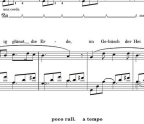PROBLEM SOLVING PRACTICE IDEAS FOR OUR PIECES

Diabelli Rondo from Sonatina Op 151 No 1 (p36)
I would like to offer two main practice suggestions that will keep you feeling coordinated in this sparkling Rondo. Using a very small wrist hinge in the LH’s broken chord pattern will help you keep this light and characterful. From a wrist that is level with the forearm, gently drop the arm into the fifth finger notes, from the key surface. As you play each repeat chord, allow the wrist to hinge up over the course of the bar – but only a couple of millimetres per chord. This very small range of motion will be enough to keep you free and mobile. It’s most important to check that you are not key-bedding (pushing into the fifth finger as you hold the key).

My other practice suggestion involves using the chaining technique to incorporate several notes into one physical gesture, the down-up
You’re reading a preview, subscribe to read more.
Start your free 30 days





